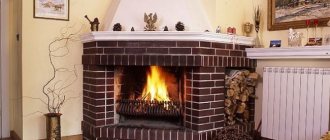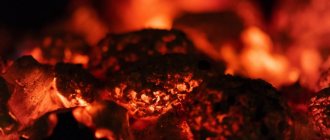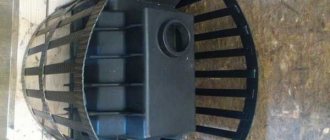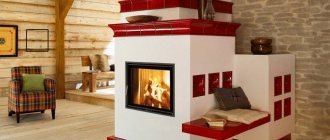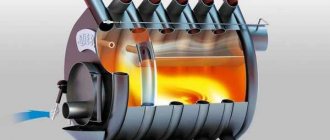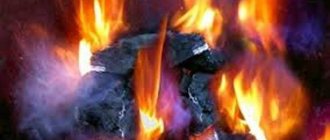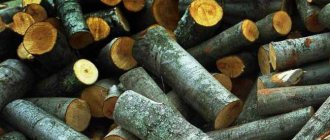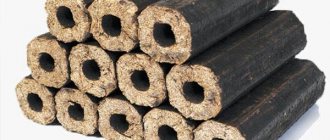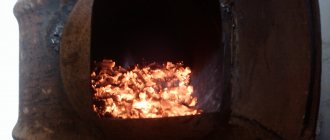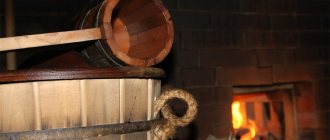A home fireplace will delight you with warmth, a stove in a kitchen or bathhouse will light up faster, and an outdoor fire will burn well only if you choose the right fuel for it. Firewood is one of the most common combustible materials for household use. The choice of wood type depends on the purpose of use. For example, if it is important to light a fire without problems or the goal is to obtain an even, beautiful flame, birch logs would be the best choice. When you need to get a “clean” combustion, the stove is heated with alder - such wood burns with virtually no soot or smoke. And the branches of fruit trees will give a pleasant aroma. But there is another important criterion for choosing logs - their size. So what is the optimal size of wood for a stove or fireplace?
What size should the firewood be?
The size of the firewood directly affects the efficiency of the stove. It is not uncommon for a certain volume of “ordinary” branches to burn 2-3 times faster and produce less heat than the same amount of firewood chopped specifically for the fireplace. The reason is the excessive subtlety of the former. However, too thick pieces of wood cannot be used - they are inconvenient to put in the firebox and they take a very long time to flare up.
The optimal diameter of a log for any heating device is 7-9 cm. And the required length of firewood for a stove (cooking, heating, sauna) depends on the dimensions of the firebox and should be from 3/4 to 2/3 of its length. On average, this will be 30-35 cm, and this is the standard length of firewood for a fireplace or barbecue, sold in bundles.
This size of firewood for a fireplace is explained by the laws of physics. If you use firewood of this size, the air flow that comes from the open ash pit will support the combustion of the entire log. The wood will not smoke; it will completely transfer its heat to the stove. In addition, logs of such dimensions will not produce too much soot, which will affect the safety of the stove, because an excess of solid combustion products in the firebox can lead to their spontaneous combustion.
How long should wood be for an open flame fire? In this case, their dimensions are not limited by the diameter of the firebox, however, the optimal size of chopped firewood is considered to be no more than 35 cm in length and no more than 10 cm in diameter.
Methods for warming up a frozen pipe:
- The first method is to eliminate the difference in air temperature inside the pipe and outside - in the room. The method is suitable for rooms with positive air temperatures. Open the door of the combustion chamber of the hearth, as well as the windows and doors in the room, so that warm air enters the room, and a draft provokes the movement of air masses inside the firebox and chimney.
- The second and main method is to warm up the chimney route. The material and design of the pipe do not matter, the process itself is important. A lit newspaper or paper should be placed in the chimney sweep door. To get the effect, you need to burn several newspapers or sheets of paper at once. The achievement of the effect should be noticeable by the behavior of the newspaper and the flame - they should be actively drawn into the smoke channel using the draft force activated after heating the pipe.
- You can also warm up the chimney using the furnace or fireplace itself. Instead of firewood, newspapers or paper should be placed in the firebox and several batches of this simple fuel should be burned. A slight but warm flame from a newspaper or paper will warm up the pipe, expel cold air into the street and normalize the draft level. As in the second method, the achievement of the effect will be noticeable by the behavior of the flame - it should tend inward and upward, towards the chimney.
- After the chimney has warmed up, you can try to carefully begin the lighting process. To do this, place a small amount of wood chips (be sure to be dry) in the firebox and light them. If the wood chips are well burned and the smoke goes up the chimney, you can start lighting the main fuel - firewood.
Attention! After heating the smoke channel through the inspection, cleaning holes and doors, they should be closed to prevent smoke and carbon monoxide from entering the room. https://www.youtube.com/embed/KJ4OA9LUoeE
And a few more simple rules
To achieve even and long burning, it is recommended to follow a number of simple rules:
- It is better to use logs of approximately the same size;
- the main combustion should be supported by sufficiently thick firewood, and thin branches and brushwood are suitable only for preliminary kindling;
- the bark from the logs must first be removed - this way you will significantly minimize the amount of soot formed during the combustion process.
It is also important to properly place firewood in the firebox. It is strictly not recommended to stuff it full of logs - it is better to fill it loosely by about 1/3 of the volume. This way you will provide sufficient draft for the fuel to burn efficiently, but you won’t have to frequently add a new portion of firewood - it will be enough to add 2-3 logs to the firebox from time to time. The damper must be open.
Recommended types of firewood for a bath
Features of the sauna fireplace “in white”
With this method, the type of wood is not a determining factor. The main requirement for firewood is minimum humidity. In order for the logs to burn well, they need to be prepared. The criteria are medium cross-section and short length (about 30 – 35 cm). If you also provide high-quality pressurization, then the temperature in the steam room can be raised to the required value quite quickly, which, in fact, is a characteristic sign of a truly good bath.
"In Black"
This technique is used much less frequently, although it is more effective. This is exactly how they drowned it in the old days. It is hardly advisable to recommend specific types of wood, if only because different baths have their own characteristics (including structural ones), and each of us interprets the concept of “procedure” in our own way. Knowing the properties of wood species, it is easy to make the best choice at your own discretion.
Fruit trees
For heating the sauna stove, mainly pear, apple, cherry and plum are used. These rocks are dense, so they maintain heat well and do not require frequent addition of a new batch of fuel.
Willow
To create heat in a sauna, willow is perhaps the most suitable wood, which also does not produce soot. But its significant drawback is that it quickly burns out.
Recommendation - you need to immediately prepare the required supply of firewood, taking into account the fact that you will have to throw it into the firebox quite often.
Birch
For a sauna stove it is considered one of the best options. When burning, which is characterized by uniformity and duration (birch is a hard species), it releases substances that are characterized by disinfectant properties. Bathing procedures using this firewood are good for colds. During the thermal reaction, the released resins not only create a special aroma in the steam room, but also protect the internal cavity of the chimney from overheating.
Recommendation – precisely because of the resins, it is not advisable to use it for initial kindling.
Oak
For a sauna stove, such firewood is considered “elite”. One stack of oak wood will burn for a long time, giving excellent heat. This wood has healing properties, and the bath procedure helps get rid of many ailments, including chronic ones.
Recommendation - if possible, you should choose oak that is at least 200 years old (the average age of a tree).
Linden
It burns slowly, but then gives a steady heat. Steam from linden wood has many healing properties.
Recommendation - when harvesting this wood for future use, you should take into account that if it is stored in a woodpile for more than 2.5 years, it loses many useful properties.
Alder
One of the most convenient options for firewood. The peculiarity of wood is that it intensively gets rid of moisture, regardless of the conditions in which it is stored. This makes it possible to sharply reduce the drying period before use. It has a number of healing properties, so it is often used for health procedures.
Recommendation – alder flares up quite quickly, so it is advisable to use it immediately to light the stove.
Aspen
This wood is necessary only for cleaning the chimney, but not for bathing procedures (it burns out quickly, and the heat does not give any effect). To achieve maximum soot removal, potato peelings should be added to the fire regularly.
Alder firewood
Application : for baths (they give an invigorating aroma and light steam), for cooking meat on coals and smoking, for fireplaces, as well as stoves (in combination with birch, oak).
It is believed that alder was used for stoves in rich estates. And a sauna with such wood is a proven means of preventing colds. It is easy to distinguish alder logs from other species: fresh cuts have a characteristic red-orange color.
"Pros" of alder
- Easy to process . It pricks, saws and cuts without much effort.
- Does not form soot . Alder firewood, on the contrary, “burns” soot out of the chimney, cleaning it.
- Contains little resin . When burning, no acrid smoke is released. The low resin content of alder is a pleasant bonus for those who use this wood to heat their bathhouse. The air in the steam room is not filled with soot, which means there is no need to open the doors and release heat along with the smoke.
- Burns well and for a long time . Firewood flares up quickly and produces a low flame, so it is good for fireplaces and especially for barbecues. When burned, they crumble into a mass of hot, long-burning coals.
- They have a pleasant aroma . Wood of this species is especially good for heating a bathhouse. And alder branches, along with birch branches, are often used for brooms.
- Well kept . Under natural conditions it is stored for at least 3 years without loss of natural properties, incl. aroma. When wet, it dries quickly, especially compared to oak and birch.
The listed characteristics are characteristic only of alder wood, which grew in dry places. If a tree has spent its entire life in a swamp, it can smoke and produce heavy steam in a bathhouse.
"Disadvantages" of alder
- Risk of buying low-quality firewood . If alder grew in a swamp, it turns from a “royal” fuel into an extremely poor option for lighting a stove and fireplace.
- Low level of heat transfer . Alder is rarely used as the main type of fuel. Most often it is combined with birch.
Low calorific value is a relative minus. Due to this, alder is suitable for fireplaces that are not designed for very high temperatures.
Oak firewood
Application : for a fireplace, barbecue, less often for a bathhouse and heating a house (due to the high cost).
Only Russians can afford the luxury of heating the stove with oak wood. Throughout the world, wood of this species is considered elite and is used primarily for making furniture. A machine of oak logs will be expensive even in the Moscow region, but many believe that this is a justified expense. Especially when it comes to lighting a fireplace or open stoves for cooking.
Finding a specimen suitable for kindling is not easy. Young oaks produce little heat, while old ones produce a lot of ash, emit minimal heat and make the air in the room heavy and stuffy. The ideal option is “middle-aged” trees.
"Pros" of oak
- Has maximum calorific value . Oak wood is very durable, it burns for a long time and gives off intense heat. The coals smolder slowly. The amount of heat generated is 15% more than from birch, and 35% more than from spruce. This allows you to reduce the consumption of logs.
- Stores well and for a long time . Oak is resistant to negative environmental influences. Does not deteriorate for a long time when stored outdoors.
- It has a pleasant and healthy aroma . The soft and slightly tart aroma of oak when burned has a positive effect on the nervous system, improves health and relaxes.
- Does not emit harmful substances when burning or rotting . The wood contains no resins, and the firewood itself burns 89%, releasing only carbon dioxide. Practically does not pollute the chimney.
The ability of oak firewood to produce intense heat is both an advantage and a disadvantage. They release so much thermal energy that not every stove can cope with such a load.
"Disadvantages" of oak
- Overly strong and durable . They are very difficult to split.
- They are very expensive . The wood is considered elite.
